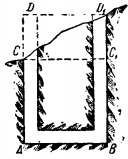To answer the questions, it is necessary to consider the aerostatic pressure produced by the columns of air at points A and B of the mine (Fig.)

The full pressure at these points consists of three parts:
(a) the pressure of the air column lying above the level DD1, this pressure being the sam for points A and B;
(b) the pressures of the columns CA and C1B; (These pressures will also be the same, since the air columns are at the same temperature, and, consequently, the air is of the same density);
(c) the pressures resulting from columns CD and C1D1.
We assume, in accordance with the conditions given, that the air temperature in the mine is lower than the temperature of the outside air in the summer.
Under these conditions, the temperature of the air column CD in the summer will be higher, and its density lower, than that of the air column C1D1. Consequently, in the summer, the pressure due to column C1D1 will be greater than the pressure due to column CD. There will exist between points A and B a difference in pressure which will disturb the equilibrium of the air in the mine and give rise to its motion from point B to point A. In the summer, the air will enter the mine opening lying at a higher level and come out of the opening lying below.
In the winter, the density of the air column CD and the pressure due to this column will be greater than the density of the air and the pressure produced by column C1D1. Hence the air will move in the opposite direction, from point A to point B.